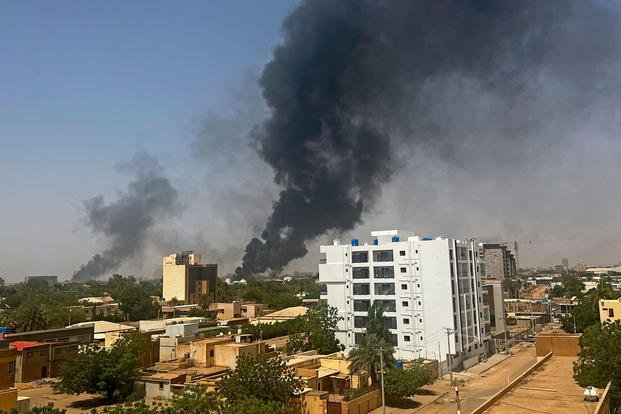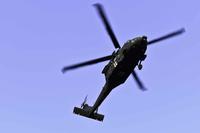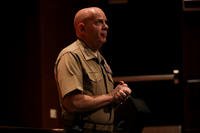The opinions expressed in this op-ed are those of the author and do not necessarily reflect the views of Military.com. If you would like to submit your own commentary, please send your article to opinions@military.com for consideration.
As the security situation deteriorates in Sudan, and thousands of US citizens remain in the war-torn country, the Navy is undertaking a mission it has done many, many times over the years: evacuations of diplomats and other Americans needing to depart a combat zone.
This is more than a humanitarian mission. The Sudan operation is providing the Navy with a chance to put some seemingly bizarre, but in fact hugely valuable, combat-support ships through their paces in a real-life situation.
Evacuations of civilians and troops are dangerous and unpredictable. Sometimes, as with the fall of Kabul in Afghanistan in 2021, they can go terribly wrong. At other times — think Vietnam in 1975 — they can be chaotic but overall fairly successful. Often when the nation in question has a coast, as Sudan does on the Red Sea, the Navy conducts the bulk of the operations.
Normally, such missions would be conducted from massive amphibious warships such as the “big deck” helicopter carriers of the Wasp and America classes. These ships ferry Marines around the world, conduct amphibious attacks and carry vertical-lift jump-jets for combat strikes ashore. But the operation in Sudan, which is (so far) relatively small, looks quite different.
While there is always a risk to evacuees, in Sudan it is unlikely that either side in the civil war would deliberately target civilians. So we are seeing the use of two warships that have little offensive combat capability but excellent, adaptable logistical-support abilities: the Brunswick and the Lewis B. Puller.
I know both of these ship classes well, having played a role in their adoption over a decade ago. The Lewis B. Puller is an “expeditionary mobile base” with a crew of only about 150 (as opposed to 5,000 on a carrier), but a huge and flexible capacity to operate helicopters, drop off special forces, provide medical and logistical support ashore, and host hundreds of civilian evacuees.
The Navy began to experiment with this type of at-sea base after the 9/11 attacks. I was heading up the tactical think tank “Deep Blue” in the aftermath of the plane striking the Pentagon. We were preparing for operations in the world’s littoral regions (shallow areas near shores) for what would become known as the Global War on Terrorism.
The Navy did not want to devote its nuclear aircraft carriers or even big-deck amphibious ships to such missions, so we looked for alternatives that were far less costly, both in terms of manpower and sticker price. These mobile bases, with hulls based on those of oilers, are large and capable — more than 750 feet long and displacing 80,000 tons. But they are a bargain at $650 million, as compared to nearly $15 billion for a new nuclear carrier.
The other main ship in the Sudan operation, the Brunswick, is far smaller but nearly three times speedier. Known as an “expeditionary fast transport,” the Navy commissioned six of these craft, which ride on a catamaran hull and can move at over 40 knots. At only 300 feet in length, they can carry more than 600 tons of cargo and, for brief periods, hundreds of passengers. Operated by a tiny crew of around 40, they even have a small but capable helicopter deck.
As commander of US Southern Command in the 2000s, I experimented with an early variant of this class for Caribbean counternarcotics operations, where we very successfully embarked alongside Coast Guard law-enforcement detachments.
Because neither of these ships is armed beyond light machine guns, a Navy destroyer is typically deployed with them to bring defensive firepower. In Sudan, the Truxton, an Arleigh Burke-class guided-missile destroyer, accompanied the Puller and Brunswick. Drones are also being used to provide overwatch ashore in case of any threat to the civilian evacuation operations.
These two new ship classes have a broad range of uses, both in noncombatant roles like evacuations but also in support of combat. To name a few potential missions: operations in the island chains of the western Pacific; oil and gas protection off the coast of Norway; counterterrorism at the Horn of Africa or islands in the Philippines; natural-disaster relief; medical diplomacy; and further evacuations of noncombatants.
The nature of security is far broader than simply lobbing Tomahawk missiles, dropping precision-guided bombs or landing Marines. The Brunswick and Puller are showing a wide spectrum of abilities for conducting operations fit for the modern world.
____
ABOUT THE WRITER
James Stavridis is a Bloomberg Opinion columnist. A retired U.S. Navy admiral, former supreme allied commander of NATO, and dean emeritus of the Fletcher School of Law and Diplomacy at Tufts University, he is vice chairman of global affairs at the Carlyle Group. He is on the boards of American Water Works, Fortinet, PreVeil, NFP, Ankura Consulting Group, Titan Holdings, Michael Baker and Neuberger Berman, and has advised Shield Capital, a firm that invests in the cybersecurity sector.
This column does not necessarily reflect the opinion of the editorial board or Bloomberg LP and its owners.
___
©2023 Bloomberg L.P. Visit bloomberg.com/opinion. Distributed by Tribune Content Agency, LLC.













